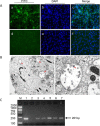Molecular detection and genotyping of bovine viral diarrhea virus in Western China
- PMID: 33531007
- PMCID: PMC7853163
- DOI: 10.1186/s12917-021-02747-7
Molecular detection and genotyping of bovine viral diarrhea virus in Western China
Abstract
Background: Bovine viral diarrhea virus (BVDV) is an important global viral pathogen of cattle and other ruminants. To survey the infection rate and genetic diversity of BVDV in western China, a total of 1234 serum samples from 17 herds of dairy cattle, beef cattle and yak in 4 provinces were collected in 2019.
Results: All the 1234 serum samples were screened individually for BVDV by RT-PCR. Our results demonstrated that the average positive rate of BVDV was 7.2% (89/1234) in animals and 82.4% (14/17) in herds. Thirteen BVDV strains were isolated from RT-PCR positive clinical samples and they were all NCP biotype. BVDV-1a and 1c subgenotypes were identified from 22 selected virus isolates in 14 BVDV-positive herds. These results confirmed that BVDV-1a and BVDV-1c were circulating in western China, similar to the BVDV epidemics in cattle in other regions of China.
Conclusions: This study provides data for monitoring and vaccination strategies of BVDV in western China.
Keywords: BVDV; Bovine; Genotype; RT-PCR; Western China.
Conflict of interest statement
All authors declared no competing interests.
Figures


Similar articles
-
Prevalence of bovine viral diarrhea virus in dairy cattle herds in eastern China.Trop Anim Health Prod. 2019 May;51(4):791-798. doi: 10.1007/s11250-018-1751-z. Epub 2018 Nov 19. Trop Anim Health Prod. 2019. PMID: 30456692 Free PMC article.
-
Outbreak of persistently infected heifer calves with bovine viral diarrhea virus subgenotypes 1b and 1d in a BVDV-vaccinated open dairy herd.Acta Trop. 2024 Jun;254:107198. doi: 10.1016/j.actatropica.2024.107198. Epub 2024 Mar 24. Acta Trop. 2024. PMID: 38531427
-
Prevalence and genetic diversity of bovine viral diarrhea virus in dairy herds of China.Vet Microbiol. 2020 Mar;242:108565. doi: 10.1016/j.vetmic.2019.108565. Epub 2019 Dec 27. Vet Microbiol. 2020. PMID: 32122580
-
A systematic review and meta-analysis of the epidemiology of bovine viral diarrhea virus (BVDV) infection in dairy cattle in China.Acta Trop. 2019 Feb;190:296-303. doi: 10.1016/j.actatropica.2018.08.031. Epub 2018 Aug 27. Acta Trop. 2019. PMID: 30165071
-
The Epidemiology and Control of Bovine Viral Diarrhoea Virus in Tropical Indonesian Cattle.Pathogens. 2022 Feb 7;11(2):215. doi: 10.3390/pathogens11020215. Pathogens. 2022. PMID: 35215158 Free PMC article. Review.
Cited by
-
Identification of NECTIN1 as a novel restriction factor for flavivirus infection.mBio. 2024 Dec 11;15(12):e0270824. doi: 10.1128/mbio.02708-24. Epub 2024 Nov 21. mBio. 2024. PMID: 39570015 Free PMC article.
-
Detection of emerging HoBi-like Pestivirus (BVD-3) during an epidemiological investigation of bovine viral diarrhea virus in Xinjiang: a first-of-its-kind report.Front Microbiol. 2023 Jul 4;14:1222292. doi: 10.3389/fmicb.2023.1222292. eCollection 2023. Front Microbiol. 2023. PMID: 37492265 Free PMC article.
-
Genetic features of bovine viral diarrhea virus subgenotype 1c in newborn calves at nucleotide and synonymous codon usages.Front Vet Sci. 2022 Aug 31;9:984962. doi: 10.3389/fvets.2022.984962. eCollection 2022. Front Vet Sci. 2022. PMID: 36118339 Free PMC article.
-
Host Cell Receptors Implicated in the Cellular Tropism of BVDV.Viruses. 2022 Oct 20;14(10):2302. doi: 10.3390/v14102302. Viruses. 2022. PMID: 36298858 Free PMC article. Review.
-
Canine circovirus among dogs and cats in China: first identification in cats.Front Microbiol. 2023 Aug 30;14:1252272. doi: 10.3389/fmicb.2023.1252272. eCollection 2023. Front Microbiol. 2023. PMID: 37711694 Free PMC article.
References
-
- Gao S, Luo J, Du J, Lang Y, Cong G, Shao J, Lin T, Zhao F, Belak S, Liu L, Chang H, Yin H. Serological and molecular evidence for natural infection of Bactrian camels with multiple subgenotypes of bovine viral diarrhea virus in Western China. Vet Microbiol. 2013;163(1–2):172–176. doi: 10.1016/j.vetmic.2012.12.015. - DOI - PubMed
MeSH terms
Grants and funding
LinkOut - more resources
Full Text Sources
Other Literature Sources

